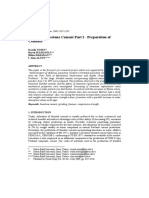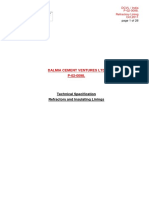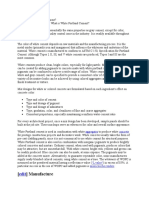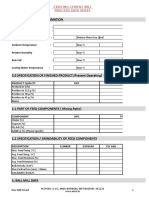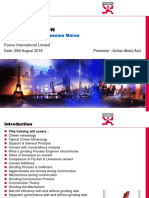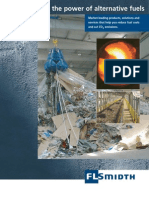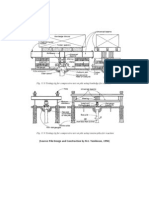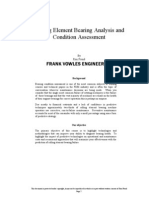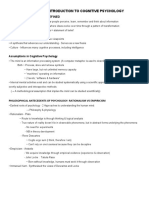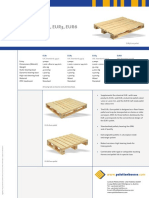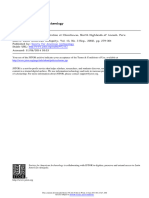Cement Chapter 2
Cement Chapter 2
Uploaded by
shani5573Copyright:
Available Formats
Cement Chapter 2
Cement Chapter 2
Uploaded by
shani5573Original Description:
Copyright
Available Formats
Share this document
Did you find this document useful?
Is this content inappropriate?
Copyright:
Available Formats
Cement Chapter 2
Cement Chapter 2
Uploaded by
shani5573Copyright:
Available Formats
2 .
1 I NT R ODUC T I ON
2 . 2 R AW MAT E R I A L S
2 . 2 . 1 I NT R ODU C T I ON
2 . 2 . 2 P L A NNI NG
2 . 2 . 3 GE OL OGY
2 . 2 . 4 E XT R A C T I ON
2 . 2 . 5 R E S T OR AT I ON
2 . 3 R AW MAT E R I A L P R E P A R AT I ON
2 . 3 . 1 WE T P R OC E S S
2 . 3 . 2 S L U R RY MOI S T U R E C ONT E NT
2 . 3 . 3 S E MI - WE T P R OC E S S
2 . 3 . 4 DRY P R OC E S S
2 . 3 . 5 S E MI - DRY P R OC E S S
2 . 4 K I L N F E E D
2 . 4 . 1 I NT R ODU C T I ON
2 . 4 . 2 C OA L GR I NDI NG
2 . 4 . 3 F I R I NG
2 . 4 . 4 F L A ME S
2 . 5 K I L N P R OC E S S
2 . 5 . 1 I NT R ODU C T I ON
2 . 5 . 2 C OMB I NA B I L I T Y
2 . 5 . 3 WE T P R OC E S S K I L NS
2 . 5 . 4 S E MI - WE T P R OC E S S K I L NS
2 . 5 . 5 DRY P R OC E S S K I L NS
2 . 5 . 6 S E MI - DRY P R OC E S S K I L NS
2 . 5 . 7 L ONG- DRY P R OC E S S K I L NS
2 . 5 . 8 P R E C A L C I NE R P R OC E S S K I L NS
2 . 6 C L I NK E R C OOL E R S
2 . 7 V OL AT I L E C OMP ONE NT
2 . 8 K I L N C ONT R OL
2 . 9 QUA L I T Y C ONT R OL
2.10 MAT E R I A L S HA NDL I NG
2. Cement Manufacturing
Process
C E M E N T T E C H N O L O G Y N O T E S 2 0 0 4 17
contents chapter 2 chapter 3
C E M E N T T E C H N O L O G Y N O T E S 2 0 0 5 18
2.1 INTRODUCTION
A simplified outline of the overall process is shown in figure 18,
which shows the process in the following stages:
1. Raw material extraction (or purchase)
2. Proportioning (for LSF, Silica and Alumina
Ratio, etc)
3. Grinding
4. Blending
5. Drying
6. Preheating
7. Calcining
8. Sintering (+ fuel preparation)
9. Cooling
10. Cement Grinding (+ gypsum)
Figure 18. Simplified Cement Process.
The above is applicable to all process types, although there are
some important differences. The process types can generally be
placed in the following categories:-
- Wet
- Semi-Wet
- Semi-Dry
- Dry or Pre-heater
- Pre-Calciner
In the wet process, raw materials have high moisture content,
say around 20%, and the raw material preparation and
blending is carried out as a slurry (ie 30-40% moisture). The
kiln serves to carry out the drying through to sintering (5-8
above). Overall fuel efficiency is low, as a result of the high
energy requirement associated with removal of the 30-40%
moisture.
The semi-wet process represents a modification to the wet
process in which the raw material extraction and preparation is
the same but that the water is partially removed by a
mechanical means prior to the kiln. This typically involves a
filter press where moisture levels are reduced to around 20% or
just below.
The semi-dry process essentially refers to the Lepol process
where the raw materials are nodulised (usually in a nodulising
dish) and then passed over a grate heat exchanger. Nodules
contain around 5-10% moisture. The heat exchanger consists of
a moving grate in which hot gases are passed through the bed of
nodules. The grate in effect carries out the drying and pre
heating stages outside of the kiln, with calcination and sintering
remaining inside the rotary kiln.
The dry-process can consist of long dry kilns, but more usually
consists of a suspension pre-heater, where the ground raw
material (raw meal) is passed through a series of cyclone stages
(usually 4) for drying and pre heating prior to the kiln.
In the pre-calciner process some of the energy is applied to the
kiln back-end
(1)
to a calciner vessel to achieve calcination of the
feed outside of the kiln. Thus the rotary kiln then essentially
carries out the sintering stage only. The heat exchange takes
place in a series of cyclone stages (up to 6).
In the pre-calciner process the degree of calcination prior to the
kiln can be around 90-95%. This compares to perhaps 30-40%
in the conventional suspension preheater kiln. However many
dry process kilns have been modified with secondary or
auxilliary firing, in which some fuel (say 15% of the total) is
fired at the back end (usually in a riser pipe). In the pre-calciner
process fuel can be split 50/50 or even 60/40 between the back-
end and front end of the kiln.
The following sections provide further details for the principal
process stages.
Note (1): Kiln front and back ends usually refer to the gas
flow rather than the material flow.
2. CEMENT MANUFACTURING PROCESS
contents chapter 2 chapter 3
C E M E N T T E C H N O L O G Y N O T E S 2 0 0 5 19
2.2 RAW MATERIALS
2.2.1 INTRODUCTION
Limestone represents the most important raw material, and as
already discussed, is typically some 80% of the mix. This means
that for 1 tonne of clinker it is necessary to have approximately
1.25 tonnes of limestone (i.e. allowing for CO
2
loss). For this
reason, the location of cement plants is dictated by the
availability of limestone.
However, before building a cement plant adjacent to a large
source of limestone there are a number of factors to be
considered.
2.2.2 PLANNING
Planning regulations, largely as a result of public environmental
pressure, are becoming increasingly complex and involved, and
have resulted in more refusals or stricter conditions being
imposed on permissions.
Planning applications need to address:-
- location of minerals
- reason for extraction
- need for extraction
- method of extraction
- time-scale for operation
- likely noise levels
- likely dust levels
- lines of sight
- vibration
- night lighting
- water table
- agriculture
- archaeology
2.2.3 GEOLOGY
In general terms raw materials for the manufacture of cement
should be:-
- low cost
- simple to prepare
- easy to crush
- easy to grind
- of suitable chemistry
and, above all in a viable, suitable location.
The role of the geologist is to establish the following properties
of the raw material reserve:-
- overburden thickness
- reserve thickness
- chemical composition
- hardness
- water levels
- variability
- joint planes
- faults
- size of reserve
2.2.4 EXTRACTION
In most cases raw materials are extracted in a quarrying
operation rather than a mine. Factors involved in a successful
quarry operation include appropriate planning of:-
- overburden removal and tipping
- mobile and fixed plant
- method of operation
- drilling/blasting requirements
- geotechnical conditions
- minimum cost extraction
- appropriate regulations
- manning requirements
- final landform for restoration
Raw material extraction efficiency can be assessed in many
ways, for example, in terms of:-
- output per man hour
- output per dumper tonne capacity
- output per unit of capital employed
- blasting rates
2.2.5 RESTORATION
The end of the land and minerals cycle is restoration. It is now
no longer acceptable to leave quarries once extraction has been
completed. Indeed, restoration often proceeds simultaneously
with extraction. Restoration work can include:-
- landforming
- seeding
- planting
- field patterns
- final use of land (e.g. farming, fishing, recreation, nature
reserve, public open space, landfill or development potential)
2. CEMENT MANUFACTURING PROCESS
contents chapter 2 chapter 3
C E M E N T T E C H N O L O G Y N O T E S 2 0 0 5 20
2.3 RAW MATERIAL PREPARATION
2.3.1 WET PROCESS
In the wet process raw materials are prepared as a slurry with a
moisture content of usually 30-40%, but sometimes as low as
25% and sometimes as high as 45%. The objective of
preparation is to produce pumpable slurry which is fine enough
for chemical combination in the kiln and which has the required
uniform chemistry.
Below is a brief description of the principal elements of a wet
milling plant. (See Figure 19).
Figure 19. Simplified Wet Process
Washmills:
Many materials used in the wet process are soft and sticky with
high moisture and do not require the high energy input of a ball
mill. The necessary tearing/attrition can be achieved in a
washmill. This essentially involves agitation with harrows
hanging into a cylindrical tank from a centrally pivoted rotating
arm (10-15 rpm). The material is thrown against screens of
around 5-6mm mesh. The slurry passes through whilst coarser
material is retained. A typical size is 10-11 metre diameter, 3-4
metres deep with a 250-300kw drive.
However, coarse residues can be a problem dictating a
secondary preparation stage in either a further washmill (higher
speed, smaller mesh, smaller size) or a ball mill.
Washdrums:
A washdrum is used where there are hard inclusions in the raw
material (e.g. flint). Effectively it is a lined steel drum like a ball
mill, but without media. The hard inclusions themselves build
up and act as grinding media. Slurry is discharged through the
shell, whilst the hard pieces pass to a second chamber or are
rejected.
The slurry can sometimes be screened, with the coarser sizes
passing to a secondary grinding stage.
Wet Ball Mills:
Ball mills can be used as primary grinders or secondary mills
and can have single or 2 or 3 chambers depending on their
application and feed material size. Linings and diaphragms can
be rubber or steel. Media sizes are typically 80-100mm
maximum and 25mm minimum. Smaller sizes tend to "float" in
low moisture slurries.
Wet Classification:
Classification to reject oversize particles can be achieved in a
number of ways, e.g.
- vibrating screen
- hydrocyclone
- sieve bend
The rejects can be returned to the primary mill, passed to a
secondary stage or totally rejected.
Screens are generally unattractive to the cement works, since
poor classification is achieved in low moisture slurries and wear
rate is high.
The hydrocyclone consists of a cylindrical head, concentric
outlet nozzle and a conical body. Slurry is introduced
tangentially where a vortex is formed. Particles in the slurry are
therefore subject to centrifugal force which pushes material to
the outer wall of the cone, and a viscous drag force opposing
this, which drags material towards the axis of the cone. (See
Figure 20).
In the sieve bend the slurry is introduced inside a 270 arc of
screen mesh. Material reaches the screen at right angles and thus
the cut size is somewhat smaller than the mesh size. This helps
overcome blinding of the screen. (See Figure 21).
Figure 20. Hydrocyclone
2. CEMENT MANUFACTURING PROCESS
Tangential inlet
Outlet Nozzle
Vortex Finder
Rejects Nozzle
Chalk (Limestone)
Oversize/Rejects
Ball Mill
Fines
Clay
Washmill
Kiln
Storage
&
Blending
Hydrocyclone
contents chapter 2 chapter 3
C E M E N T T E C H N O L O G Y N O T E S 2 0 0 5 21
Figure 21. Sieve Bend
Blending:
Even though the feed materials are carefully proportioned in the
preparation plant, the resultant slurry will usually have some
variability as a result of changes in clay moisture, feed rates and
chemistry. A blending and storage system thus aims to provide a
uniform kiln feed slurry.
Blending and mixing can either be a batch or continuous
process.
2.3.2 SLURRY MOISTURE CONTENT
Naturally, the higher the moisture content of the slurry the
higher will be the energy requirement in the kiln. Slurry
moisture will depend on a number of factors, such as:
- raw material properties
- mix design
- materials handling system
- dust return
There are generally two ways to reduce the moisture content:
- use of chemical slurry thinners
- mechanical de-watering
Figure 22 represents a typical relationship between the kiln feed
moisture and the specific heat consumption of the kiln.
Figure 22. Effect of Kiln Feed Moisture on Energy Requirement
In essence, the slurry is a mixture of water and fine dispersed
particles. The mixture has a specific viscosity and thus specific
handling behaviour. Slurry thinners are used to reduce the water
content for a given viscosity.
In general, each percent of water reduction equates to an
increase in kiln capacity of 1.5% and a 1% reduction in the
kcals/kg e.g., as shown in Figure 22, reducing by 5% from 38%
to 36.1% would yield approximately a 5% reduction in
kcals/kg.
The slurry thinners are usually added to the grinding stage and
thus can also act as grinding aids. Their effect depends on the
physical and chemical properties of the slurry and so the choice
of additive is usually based on experimental trials.
The ions and molecules of the chemical added are absorbed
onto the particles of the raw mix thereby preventing
agglomeration and reducing internal friction. Hence flowability
of the slurry is improved.
There are two main groups of slurry thinners:-
- alkaline electrolytes
- surface active organic substances
A list of substances used by the cement industry is shown in
Figure 23. Combinations of these materials are often used. The
alkaline electrolytes can be limited due to their contribution to
the input of alkalis.
Mechanical de-watering represents the semi-wet process.
Figure 23. Examples of Slurry Thinners
2. CEMENT MANUFACTURING PROCESS
Akaline Electrolytes Sodium Silicate
Sodium Hhydroxide
Sodium Carbonate
Sodium Trypolyphosphate
(STPP)
Surface Active Organics Lignin Derivatives
Humic Acids
Sulphite Liquor
Calcium Lignosulphonate
Carbonaceous Additives
Molasses
The curved screen
is made of wedge
shaped wires
Slot width
Feed
Coarse Particles
rejecte
Slurry
Stream of slurry
passes across screen
at high velocity
Rejects Fines
contents chapter 2 chapter 3
C E M E N T T E C H N O L O G Y N O T E S 2 0 0 5 22
2.3.3 SEMI-WET PROCESS
In the semi-wet process raw material extraction and preparation
is the same as that used in the wet process. However, once the
slurry has been produced the water content is mechanically
reduced before introducing the raw feed to the kiln.
The slurry de-watering can be achieved in drum or disc filters in
continuous operation or in filter presses operated in batch
mode. The latter results in a filter cake of 18-20% moisture.
(See Figure 24).
Figure 24. Simplified Semi-Wet Process
In the filter press the slurry is pressed between metal plates
covered by a filter cloth. The resultant cake is often "chopped"
into briquettes and collected into a store before being fed to the
kiln.
Another alternative for modifying the wet process concerns the
use of a spray dryer, which can achieve good heat transfer by
the close contact of gas and slurry presented as droplets. The
kiln then becomes shorter, like the dry process.
2.3.4 DRY PROCESS
Like the wet process, the objective of preparation is to achieve a
desired fineness and chemistry, but as the process name suggests,
also to achieve drying.
The materials for the dry process are usually relatively low in
moisture and thus, in comparison to the wet process, are dried
to produce a dry kiln feed powder rather than additional water
to produce a slurry.
The principal stages involved are described below:
Crushing:
The objective of crushing is to provide raw materials of a size
suitable for fine grinding. Sometimes only 1 stage of crushing is
needed, but more often there are 2 or 3 stages necessary for the
required size reduction.
The selection of the crushing circuit will depend on:-
- feed size
- required produce size
- moisture content
- stickiness
- hardness
- abrasivity
Crusher types in use include (See Figure 25)
- gyratory
- impact
- roll
- hammer
- cone
Grinding:
In grinding the main objectives are to:-
- produce the fineness required for the kiln process
- remove the remaining moisture
This then achieves a product, usually referred to as raw meal,
which is fine, dry and free flowing.
The most effective way of removing the moisture is during the
grinding process by passing a stream of hot gas through the
mill. This is normally waste heat from the kiln system.
There are three principal types of mill used in the cement
industry:-
- Ball mill
- Aerofall mill
- Roller mill or Vertical Spindle mill
Figure 25. Examples of Crusher Types
2. CEMENT MANUFACTURING PROCESS
Gyratory Crusher Cone Crusher
contents chapter 2 chapter 3
C E M E N T T E C H N O L O G Y N O T E S 2 0 0 5 23
The Aerofall mill is a special case of a very short and large
diameter rotating mill. There are only a relatively few large
grinding balls, the majority of grinding achieved by the material
itself.
Grinding circuits can appear quite complex and varied in raw
material grinding (when compared to those of cement grinding),
and so it is not the intention to cover these in detail here.
Below are some features of raw material grinding circuits:-
- Circuits can often contain
- drying
- grinding stage(s)
- transport
- classification stage(s)
- Drying can be in a separate stage, like a drum dryer, or in the
grinding stage (e.g. in a pre-grinding stage or in the mill) or
in the classification stage
- Mills can be ball mills, Aerofall, double rotator (central
discharge), roller mill or roll press. Pre-grinding is often
achieved in hammer mills or impact crushers
- Classification can be achieved in static, mechanical, cyclone
or high efficiency separators or a combination of them
- Material transport can be achieved in bucket elevators or by
air sweeping or by a combination of them
Examples of such raw material grinding systems are shown in
Figure 26.
Figure 26. Examples of Raw grinding Circuits
Figure 26. Examples of Raw grinding Circuits (continued).
2. CEMENT MANUFACTURING PROCESS
Pre-Drying Chamber Pre-Drying Duct
Pre-Drying Impact Mill
Pre-Drying Impact Mill,
Central Dicharge Mill,
and Air Separator
Pre-Drying, Pre-crushing Impact Mill
Drying in Air Separator Pre-Drying in Duct Air-
Swept Mill
Impact Crusher Roll Crushers
Hammer Crushers
Single Roll
Double Roll
Single Rotor
Double Rotor
contents chapter 2 chapter 3
C E M E N T T E C H N O L O G Y N O T E S 2 0 0 5 24
In general the product moisture should be below 0.5%. Feed
moistures of up to 8% can usually be dried by using pre-heater
exhaust gas, whilst above this it maybe necessary to use
auxiliary heating.
In comparison the grinding circuit for a roller mill appears
relatively simple since the mill has an internal classifier,
generally internal material transport, and simultaneous grinding
and drying.
Roller mills are becoming increasingly used for raw material
grinding, although the roll press (see section 5) is also finding
applications in raw grinding circuits.
The roller mill is a development of the flour stone mills, which
were driven by wind or water. Material is fed onto a rotating
table and is crushed/ground by the action of 2, 3 or 4 rollers,
which press onto the table. As material leaves the edge of the
table, airflow transports it to the classification stage. Rejects are
returned down the centre of the mill body to the grinding table.
(See Figure 27).
Figure 27. Vertical Roller Mill.
Material is retained on the table by a retaining (or dam) ring,
which allows the formation of a material bed on the table. Air
flows through a "nozzle ring" at the edge of the table.
Some of the important operating features include:-
- Feed properties (e.g. ability to form bed of material)
- Bed depth
- Dam ring height
- Nozzle ring velocity (can be 40-70 m/sec)
- Gas flow (around 2kg gas/kg solids)
- Use of water sprays (to modify material bed
properties and control outlet temperature)
- Operating pressure (arising from static and
hydraulic forces)
- Material feed size and feed rate
- Differential pressure (proportioned to feed rate)
- Separator rotational speed
- Wear rate
- Vibration (function of bed properties)
Blending:
As for the wet process, the product from the grinding circuit
will usually require homogenisation to provide a uniform and
consistent kiln feed material.
Inhomogeneous kiln feed can adversely influence:-
- cement quality
- kiln output
- fuel consumption
- refractory life
Blending has already begun in the quarry, stockpiles and the
raw milling circuit. However, the final stage is the blending silo.
As with the wet process this can be batch or continuous in
operation.
Figure 28. Raw Meal Quadrant Blending System.
The blending silos achieve homogenisation through the use of
fluidising air to achieve a liquid like powder (i.e. fluidised
powder).
Parts of the silo are fluidised, usually via porous tiles or canvas,
in turn thereby creating movement of material from one part to
another. There are many variations of systems to achieve this
using various designs of segments and high/low pressure airflow.
Some of these are illustrated in Figure 28.
The blended raw meal is then stored in one of several kiln feed
storage silos. Some opportunity for final adjustments to the kiln
feed can then be achieved, if necessary, by simultaneously
extracting from more than one silo.
2.3.5 SEMI-DRY PROCESS
In the semi-dry process ((Lepol) the raw feed is processed with
some 10% moisture in pre-wetting screws. The material is then
fed to a nodulisation process, such as an inclined dish, in which
a tumbling action processes the material which becomes
"rolled" into nodules. These nodules are then pre-heated in a
grate before passing to the kiln (See section 2.5).
2. CEMENT MANUFACTURING PROCESS
contents chapter 2 chapter 3
C E M E N T T E C H N O L O G Y N O T E S 2 0 0 5 25
2.4 KILN FUEL
2.4.1 INTRODUCTION
As already discussed in section 1, coal remains the most widely
used primary fuel.
Whilst coal has abundant supplies at relatively low cost, it
presents some handling problems, contains moisture and often
significant ash levels, requires preparation and can be variable
in calorific value.
In comparison, oil has no moisture, low ash and is easy to handle,
but can be expensive and tends to have a higher sulphur content.
2.4.2 COAL GRINDING
Coal grinding methods can generally be characterised into:-
- high speed impactor type
- medium speed vertical spindle type
- low speed tumbling type
High speed mills include the Attritor where grinding is achieved
by impact by rotating hammers and attrition between particle
collision. Mill speeds can be 1700-1800 rpm with peripheral
speeds of around 80m/sec.
Vertical roller mills are like those used for raw material grinding
although grinding can be achieved on the table under balls (in a
ring) or rollers.
Ball mills are also used for coal grinding.
Like the raw material grinding described in section 2.3, coal
grinding also involves simultaneous drying.
2.4.3 FIRING
The air used in grinding is also used to convey the pulverised
coal or fuel (usually referred to as pf) to the kiln.
Where fuel is conveyed directly from the mill to the kiln the
system is referred to as a direct firing system.
Where the fuel and air are separated and the pf is stored in a
hopper from which it is later fed into an air stream into the
kiln, this is referred to as an indirect firing system.
A comparison of these two approaches is shown in Figure 29.
Figure 29. Comparison of Direct and Indirect Firing Systems.
Air for drying and conveying is usually taken from the kiln
hood and is normally kept below 350C to avoid ignition by
using a cold air bleed.
Combustion requires about 10 kg air/kg coal
Fuel is introduced into the kiln via a firing pipe with 5-40% of
the total combustion air. The firing nozzle is sized to give a
nozzle velocity of 30-100m/sec. The remainder of the air
required for combustion is supplied, preheated, from the clinker
cooler.
Naturally there are a certain number of safety requirements
when handling powdered coal. Powdered coal suspended in air
will explode if in a concentration of 0.04-3kg/m3, depending on
volatiles and particle size. An ignition source, e.g. a spark is
required to cause an explosion, although damp coal in air can
ignite spontaneously if left for a period of time (can be only
days).
In indirect systems where pf is stored, spontaneous fires can
occur.
2.4.4 FLAMES
Flame characteristics are largely influenced by:-
- coal preparation
- burner momentum
- axial location
- back end oxygen
Inappropriate characteristics can adversely affect economy,
output, clinker quality and kiln lining. In particular poor burner
design can cause:-
- chemical reducing conditions
- ash heterogeneity (i.e. poor combination of ash)
- variable burning
- under/over burning
- damage to refractories
Thus the kiln flame can influence a large number of parameters
such as:-
- 28 day strength
- Workability
- Setting
- Fuel consumption
- Volatile recirculation
- Early/late strength relationship
- Decreased refractory life
- Increased cement grinding kWh/t
- Increased pollutant emission
2. CEMENT MANUFACTURING PROCESS
Direct Firing
Advantages: Relatively simple system
Storage of fine coal not necessary
Lower capital cost
Disadvantages: Primary air (from mill system)
dictated by the mill requirements
Coal feed rate linked to mill output
Mill failure will require kiln
shutdown
Indirect Firing
Advantages: PF storage permits kiln operation
without mill
Coal fee rate readily adjustable
Primary air independent of mill rate
Disadvantages: Fine coal needs to be stored
(safety hazard)
Additional equipment needed for
caol/air separation and re-
entrainment from storage
contents chapter 2 chapter 3
C E M E N T T E C H N O L O G Y N O T E S 2 0 0 5 26
2.5 KILN PROCESS
2.5.1 INTRODUCTION
Referring to the stages shown in Figure 18, the kiln can achieve
the 5 stages from raw meal production to clinker, i.e.:-
- drying
- preheating
- calcination
- sintering (burning)
- cooling
However these should not be seen as independent process
stages, since considerable overlapping occurs.
Drying Zone:
In the wet and semi-wet processes, slurry water is evaporated
off by heat in a chain section in the kiln and the water vapour
leaves the kiln with the back-end gasses. Temperatures can
exceed 100C.
In the semi-dry and dry process the drying takes place outside
the rotary kiln.
Pre-Heating Zone:
In this stage the raw meal is gradually heated to remove water
of crystallisation and the temperature rises to 700-850C. In
the semi-dry and dry process this again takes place outside of
the kiln.
Calcination (Decarbonation) Zone:
Calcium carbonate dissociates at about 1000C producing
reactive lime and carbon dioxide gas.
In the wet and semi-wet process this takes place in the rotary
kiln just before the burning zone. In the semi-dry and dry
process around 30-40% of the decarbonation has taken place
outside the kiln. In the precalciner process the majority (>80%)
of decarbonation is achieved outside the kiln.
Burning Zone:
Here the main reactions between lime and silica, alumina and
ferric oxide take place to produce the clinker minerals.
In these reactions heat is actually generated, adding to the heat
from the flame, and thus the temperature rises rapidly to around
1450C. Some 25% of the material (flux) become molten at this
stage.
Cooling Zone:
Cooling begins immediately after the maximum temperature has
been reached. The resultant clinker is rapidly cooled by the
incoming secondary air. The flux solidifies and the clinker
minerals become fixed before the clinker passes the nose ring.
2.5.2 COMBINABILITY
In general terms the main objective in the kiln process is to
produce as much C
3
S from the lime and silica as possible,
minimising the amount of uncombined lime (free lime). Thus
the aim is to maximise the amount of oxides reacting with lime.
In practice the kiln is operated by controlling the level of free
lime. The target is often 1-1.5% free lime in the clinker.
Besides the percentage of Alite (C
3
S), the crystal sizes should be
kept relatively small for best reactivity in the clinker (and hence
the cement). This is assisted by having a raw mix that can be
burned to the target free lime as easily as possible.
The ease to which this can be achieved (referred to as the
"combinability" or "burnability") is primarily a function of:-
- raw meal chemistry
- raw meal fineness (and distribution of components)
- raw material mineralogy
The combinability properties of a given raw meal can be
evaluated in laboratory tests where the temperature for a given
free lime is determined. (See Figure 30).
Figure 30. Typical Combinability Curves.
The combinability has a significant influence on:-
- kiln fuel consumption
- clinker microstructure (hence cement quality)
- kiln operation (e.g. volatile recirculation and
build-ups)
Combination in the kiln is influenced by:-
Burning Temperature:
From Figure 30 it is evident that the amount of uncombined
lime remaining in the clinker decreases as the burning
temperature increases. The actual relationship varies from one
raw mix to another and this will influence the relative ease at
which a given free lime can be controlled.
Raw Meal Fineness:
Finer grinding facilitates combination (See Figure 31), since finer
materials are more intimately mixed and have a higher surface
area for reaction.
2. CEMENT MANUFACTURING PROCESS
contents chapter 2 chapter 3
C E M E N T T E C H N O L O G Y N O T E S 2 0 0 5 27
Figure 31. Combinability Effect of Raw Feed Fineness.
Lime Saturation Factor:
As LSF increases combination becomes more difficult (See
Figure 32a) and near to 100% LSF the combinability
temperature rises sharply.
Silica Ratio:
As for LSF, an increase in silica ratio results in an increase in
combinability temperature (See Figure 32b). This arises since as
silica ratio increases the amount of flux available decreases
thereby reducing mobility and ease of reaction.
Figure 32a. Combinability Effect of Clinker LSF.
Figure 32b. Combinability Effect of Clinker Silica Ratio.
Alumina Ratio:
Unlike LSF and silica ratio, there is an optimum alumina ratio
for minimum combinability temperature. (See Figure 33). This
arises since at 1.4 - 1.6 alumina ratio the amount and viscosity
of the flux are at an optimum for the oxides to move and react.
In addition the maximum amount of liquid phase occurs at the
start of melt formation, thereby facilitating early combination.
Figure 33. Combinability Effect of Clinker Alumina Ratio.
Nature of Raw Materials:
The achievement of close proximity between lime and the other
oxides can be influenced by fineness and the amount and nature
of the flux, as discussed above. However it can also be strongly
influenced by the nature of the raw material minerals, such as
the heterogeneity of silica and calcareous residues. Thus the
composition of the coarse fractions (e.g. at 90 microns) can be
as important as the magnitude of the residue. These can
sometimes be rich in siliceous or calcareous materials.
2.5.3 WET PROCESS KILNS
As already discussed the feed material typically contains 30-
40% moisture. The kiln is a refractory lined steel cylinder
supported on tyres and rollers. It is inclined by about 3 from
the feed end (back-end) and rotates typically at 1-2 rpm. The
rotational speed is designed to give circumferential speeds of 40-
70 cm/sec. Material passes through the kiln as a result of the
incline and rotation.
Large wet kilns, such as those at Lafarge UK (formerly Blue
Circle), Northfleet, can be as large as 5.6m diameter by 200m
long, producing 80-90 tonnes per hour of clinker.
In the first part of the kiln there is a system of chains, which
increase the overall thermal efficiency. Here drying is achieved
2. CEMENT MANUFACTURING PROCESS
% 90 Micron Residue
Silica Ratio
Aluminium Ratio
Aluminium Ratio
Lime Saturation Factor (%)
contents chapter 2 chapter 3
C E M E N T T E C H N O L O G Y N O T E S 2 0 0 5 28
and material reaches around 150C. This can typically
represent 30-34% of the kiln length.
In the next part material temperature gradually rises to around
900C where de-carbonation occurs. This can represent a
further 40-50% of the kiln length.
It is in the latter part of the kiln, near the flame, where the
sintering and clinkering reactions occur at 1300 - 1500C. This
can represent only some 15-20% of the kiln length.
Cooling commences in the last 2-3% of the kiln before material
passes the nose ring into the cooler.
Approximately 2.45 tonnes of slurry (35% moisture) is required
to produce 1 tonne of clinker together with around 0.2 tonnes
of standard coal. Fuel consumption can be as high as 1400 -
1700 kcal/kg clinker.
During this process a certain amount of dust is entrained with
the gases and leaves the kiln. This requires collection, usually in
electrostatic precipitators. Under adverse conditions the gross
dust loss could be uneconomically high (as much as 30-40%),
hence at least a proportion is usually returned to the kiln,
e.g. by:-
- blowing into the kiln (via the burner or a
separate pipe)
- returning to the slurry
- dust scoops (scoops and seals located at the end of
the drying zone which feed material back through
the kiln shell)
However, it is often necessary to discard some dust from the
kiln system. This is referred to as the net dust loss and can
typically be 5-10%.
2.5.4 SEMI-WET PROCESS KILNS
These can be the same as wet process kilns although the chain
system needs modification to accommodate the lower feed
moisture.
Alternatively the filter cake can be briquetted and pre-heated
outside the kiln, for example on a moving grate similar to the
Lepol process.
In general around 2 tonnes of filter cake and 0.18 tonnes of coal
are required for each tonne of clinker. Fuel consumption can be
around 1100 - 1300 kcals/kg.
2.5.5 DRY PROCESS KILNS
In the dry process, drying and preheating is achieved outside the
kiln in a suspension preheater.
The suspension preheater (See Figure 34) consists of a series of
cyclones (usually 4) acting as heat exchangers. The raw meal
passes through these cyclones counter-current to the hot gases.
Figure 34. Suspension Pre-heater.
Referring to Figure 34, the raw meal is fed into the gas inlet of
stage I. The meal then drops from the base of stage I and passes
into the gas inlet of stage II, and so on through the stages. The
hot kiln gases first pass from the kiln to stage IV and then stage
III and so on.
It is essential that the cyclone design achieves good mixing and
thus good heat transfer.
Material entering the kiln can be at around 1000C and some
30% decarbonated. The preheater exit gases will be at around
350C.
The rotary kiln is shorter than that used in the wet process since
only calcination and sintering is achieved in the kiln.
In general around 1.6 tonnes of dry raw meal and 0.12 tonnes
of standard coal are required for each tonne of clinker. Since
the overall heat transfer is relatively efficient, fuel consumption
is significantly lower at around 800 kcals/kg.
The dust leaving the preheater stack is usually returned to the
system via the raw milling or blending silos.
In recent years the suspension preheater system has been
modified with secondary or auxiliary firing. Here some 10-
20% of the total fuel requirement is burned in the riser pipe to
stage IV, thereby increasing the degree of decarbonation. The
energy input is balanced to the decarbonation and thus there is
no change in the temperature.
2.5.6 SEMI-DRY PROCESS KILNS (LEPOL)
This is similar to the dry process but:-
- the raw feed contains some 10% moisture and is in
the form of nodules
- preheating is achieved in a moving grate rather
than cyclones
The Lepol grate is effectively an endless grate in a refractory
lined chamber. A bed of nodules is moved by the grate and hot
gases are passed through this. Heat exchange is relatively
2. CEMENT MANUFACTURING PROCESS
contents chapter 2 chapter 3
C E M E N T T E C H N O L O G Y N O T E S 2 0 0 5 29
efficient and fuel consumption as low as 800-820 kcals/kg can
be achieved.
Because the kiln feed is pre-formed into nodules, the
assimilation of ash into the clinker is difficult. For this reason it
is usual for the Lepol process to require low ash fuels.
2.5.7 LONG DRY PROCESS KILNS
As the name suggests these are like wet process kilns but where
there is a dry raw meal. The kiln serves to complete drying
through to clinkering. Sometimes there maybe a single stage
preheater.
2.5.8 PRECALCINER PROCESS KILNS
The precalciner is development of the suspension preheater,
where in addition to the cyclones, there is a chamber (or
precalciner) where some of the fuel is burnt. As much as 50-
60% of the total fuel requirement can be burned in the calciner
and 90% decarbonation of the raw meal can be achieved. A
simplified flowsheet is shown in Figure 35. However there are
many designs of precalciner system.
The main advantage of this process is the large increase in
clinker production that can be obtained from the kiln.
Conversion of preheater operation to precalciner operation can
double kiln capacity.
Kilns of 6m diameter and 10,000 tonnes per day are in
operation.
Fuel consumption is generally similar to that of the preheater
although fuel consumption of less than 800 kcals/kg are being
achieved.
Figure 35. Simplified Kiln with Precalciner.
A summary of the main features of a modern kiln system are
shown in Figure 36.
Figure 36. Modern Kiln System Features.
2. CEMENT MANUFACTURING PROCESS
contents chapter 2 chapter 3
C E M E N T T E C H N O L O G Y N O T E S 2 0 0 5 30
2.6 CLINKER COOLERS
Although an important part of cooling commences in the kiln,
clinker leaves the kiln at around 1200-1300C and thus needs
cooling to around 100-150C for handling and heat recovery to
minimise fuel consumption. An efficient cooler can recover as
much as 70% (say 210 kcals/kg) of the heat leaving the kiln.
Cooling of clinker is achieved in one of three types of cooler:-
- Rotary
- Satellite or planetary
- Grate
These are schematically shown in Figure 37.
Figure 37. Principal Types of Clinker Cooler.
Rotary Coolers:
This is a simple rotary tube inclined like the kiln. The clinker
tumbles as it passes along the length of the cooler and air is
drawn through the cooler and into the kiln.
Clinker can be cooled to around 150C, whilst the air is
preheated to around 700C.
Satellite or Planetary Coolers:
Unlike the rotary cooler, which is a unit independent of the kiln,
the satellite cooler consists of a number (often 10) of tubes
attached to the kiln. Clinker passes directly to these tubes where
cooling takes place in a manner similar to that of the rotary
cooler.
Grate Coolers:
The most important and most common type of cooler consists
of a moving grate where a bed of clinker on the grate is cooled
by passing air through it. Some of the heated air is used in the
kiln, although a certain amount is exhausted through a
precipitator.
2. CEMENT MANUFACTURING PROCESS
contents chapter 2 chapter 3
C E M E N T T E C H N O L O G Y N O T E S 2 0 0 5 31
2.7 VOLATILE COMPONENTS
The behaviour of alkalis, sulphur and chloride in cement
manufacture can have a very significant influence on both
process operation and ultimate cement quality.
The actual effects are influenced by:-
- input levels
- alkali/sulphate ratio
- process type
- process operation
Only part of the alkalis and sulphur are fixed in the clinker,
whilst part are volatilised in the burning zone and carried to the
back-end of the kiln system. The latter condense onto solids in
the lower temperature regions of the back-end or preheater.
In the wet process the volatiles largely condense on the dust
leaving the kiln and so the overall retention of alkalis can be
relatively low, depending on the level of net dust loss. Typically
some 60% of K
2
O and Na
2
O is retained in the clinker, whilst
only 25-35% of SO
3
is retained. In general these volatiles do
not build-up a very large circulation unless a high level of dust
return is employed.
The wet process is relatively tolerable to input of chloride,
although the majority ends up in the dust.
In the Lepol process retention is a little higher since there is
usually a lower net dust loss. Typically retention of alkalis will
be 70-80% and retention of SO
3
will be around 30-50%.
In the suspension preheater there is little net dust loss from the
system and hence overall retention is high (around 90%). The
alkalis, sulphur and chloride are volatilised in the burning zone
and generally condense in the last stage of the preheater. The
volatilisation of SO
3
can be significantly increased in the
presence of kiln reducing conditions.
Some condensation can occur on the cyclone walls causing
problematical build-ups or deposits. The majority condense on
the incoming feed, which returns the volatiles back to the
burning zone for re-volatilisation. Hence large circulating loads
can build up in this way.
The nature of the deposits depends on the total input levels of
volatiles, but also on the ratio of the individuial materials.
Where there is excess sulphur there is a greater risk of hard-
based calcium sulphate deposits. For an excess of alkalis, there
is a risk of hard-based alkali carbonate. For a balanced alkali
and sulphate input alkali sulphate deposits form which seem to
be less problem causing with a tendency for self-removal.
Compared to alkalis and sulphur, chloride has a very high
volatilisation rate (around 97-99%) and thus a very large
circulating load forms. As a result the concentration of chloride
in the lower preheater stages can often reach some 30-50 times
the input level.
For this reason the dry process cannot tolerate a high level of
chloride input and chloride usually has to be limited to below
0.03% on clinker.
In extremes, where the volatile input causes significant
problems, a gas bleed (or bypass) can be used. Here part of the
kiln gases containing the volatiles is withdrawn from the kiln
and the volatiles removed before they condense causing
problems. However there is a significant adverse influence on
the overall economy.
In most cases the threat of severe deposits or build-ups is taken
care of by mechanical and pneumatic devices fitted at strategic
places. These "shock" or "blast" any deposits thereby
preventing their build-up.
2. CEMENT MANUFACTURING PROCESS
contents chapter 2 chapter 3
C E M E N T T E C H N O L O G Y N O T E S 2 0 0 5 32
2.8 KILN CONTROL
In common with the rest of the cement making process there is
a high degree of process control in the kiln system. In recent
years there have been many developments in sophisticated
computer control.
The objective of computer systems to operate and control the
kiln was to overcome the natural manual tendency of erring on
the side of caution. Potential benefits include:-
- lower burning temperature
- fuel savings
- increased capacity
- reduced refractory wear
- easier grindability clinker
The first stages of good kiln control involve:-
- raw meal feed rate
- coal feed rate
- kiln speed
- kiln airflow
- dust return
To assist in their adjustment the following parameters need to
be monitored:-
- kiln exit NO
x
- kiln exit O
2
- kiln exit CO
- back end temperature
- kiln amps
- kiln speed
- feed rate
- fuel rate
- damper position or fan speed
A list of potential reasons for kilns not remaining in optimum
burning condition is shown in Figure 38.
Modern automated kiln control systems include the use of:-
- expert systems
- fuzzy logic
- rule based control
Figure 38. Examples of Reasons for Kiln Instability.
2. CEMENT MANUFACTURING PROCESS
Kiln Feed Compostional Variability
Kiln Feed Physical Changes (e.g. Residue)
Kiln Feed Moisture Content Variation (especially Wet
Process)
Kiln Feed Rate Variability
Coal/Fuel Chemical Compostional Variability
Coal/Fuel Ash Content Variation
Coal/Fuel Moisture Content Variability
Coal/Fuel Physical Changes (e.g. Residue)
Coal/Fuel Feed Rate Variability
Heat Loss from Kiln Variability
Inleaking Air Variability
Change in Kiln Speed
Kiln Lining Coating Breakaway
Refactory Brick Loss
Kiln Dust Loading Variability
Kiln Airflow Variability
Secondary Air Temperature Variation
Changes in Cooler Conditions
contents chapter 2 chapter 3
C E M E N T T E C H N O L O G Y N O T E S 2 0 0 5 33
2.9 QUALITY CONTROL
2.9.1 INTRODUCTION
A quality assurance (QA) programme sets the policies,
standards, methods and specifications for quality control
procedures. It covers all the activities and functions concerned
with the achievement of quality. Quality is best described as
"fitness for purpose".
Quality control concerns the day to day, hour to hour
monitoring and control of conformance to the Q.A.
requirements.
In the cement industry, quality is often taken to refer to strength
and workability. However, consistency is probably the most
important parameter.
Some of the key parameters involved in good quality control
include:-
- kiln feed LSF, silica ratio and alumina ratio
- clinker free lime
- cement SSA
- cement SO
3
However, other parameters, such as alkalis (particularly the
water-soluble alkalis), cement 45-micron residue and loss on
ignition have a very marked influence in final cement
performance.
The following sections provide a brief outline of the input to
overall quality control throughout the cement making process.
2.9.2 QUARRYING
There is an opportunity here to reduce variability as much as
possible so that control in later stages becomes easier. Therefore
it is important to have a good knowledge of the material
deposits. This then allows the possibility of an optimum
planned extraction of materials.
2.9.3 CRUSHING AND STORAGE
Before the fine grinding stage the ex-quarry material is crushed
and stored. Modern practice of stacking and reclaiming raw
materials can be an important stage in reducing variability of
chemistry, usually in terms of the LSF and silica ratio.
2.9.4 RAW MILLING
In raw milling the various mix components are brought together
using controlled weighers. Continuous monitoring of LSF, silica
and alumina ratios allow adjustments to feeders. Fineness,
usually at 90 and 300 microns, is also controlled to desired
levels.
2.9.5 BLENDING
Final kiln feed adjustments are made in the blending system.
Variability can often be reduced by a factor of 10. Typical
variations that are desired at this stage are:-
- LSF 1%
- S/(A+F) 0.1
- A/F 0.1
- 90 micron 1%
Note: Between day standard deviations
2.9.6 KILN FUEL
Some of the key parameters for the fuel were discussed in
section 1, and many of these are designed in the purchase
specification e.g. calorific value, volatile matter, sulphur,
chloride, hardness, abrasivity and ash.
As discussed, ash in the fuel has to be treated as a raw material.
In general a 1% change in ash will influence the LSF by about
4%. Cement plants can operate with a wide range of ash
contents in the main fuel, but only if at constant levels.
Coal fineness is mainly a function of the volatile matter and is
typically controlled by the 90-micron residue.
2.9.7 CLINKER
Kiln control was briefly discussed in section 2.8, where the main
objectives of control are to produce a uniform clinker with
respect to chemistry, microstructure and free lime.
Part of the control involves gas temperatures, CO, O
2
, SO
2
,
NO
x
. Generally free lime is targeted between 0.5 and 2.0%.
Levels below 0.5% are often indicative of overburning, whilst
above 2.0% are indicative of unstable kiln operation or poor
raw feed chemistry control.
High free lime clinker requires separate storage for controlled
low addition during cement grinding.
Naturally it is difficult to produce a good low variability clinker
from a poorly controlled raw feed.
It is usual to make full chemical analyses (XRF) of clinker on a
routine basis.
2.9.8 CEMENT MILLING
A more detailed assessment of the relationship between cement
quality and cement grinding is made in section 8. However the
following are the principal parameters to be controlled:-
- clinker feed rate
- non-clinker component(s) feed rate
- stored clinker feed rate
- gypsum feed rate
- SO
3
content
- blaine fineness
- 45-micron residue
- milling temperature
and also the grinding additive.
2.9.9 CEMENT PERFORMANCE
Cement performance can be measured in many ways and this is
discussed in Section 7. However for quality control purposes the
main parameters are:-
- strength, EN196 mortar at 2, 7 and 28 days
- SO
3
level
- alkali level
- fineness
- slump or equivalent
A summary of these parameters and typical between-day
standard deviations are shown in Figure 39.
2. CEMENT MANUFACTURING PROCESS
contents chapter 2 chapter 3
C E M E N T T E C H N O L O G Y N O T E S 2 0 0 5 34
Figure 39. Typical Between-Day Standard Deviation Targets.
2. CEMENT MANUFACTURING PROCESS
Kiln Feed: LSF 1.0
Silica Ratio 0.07
Alumina Ratio 0.05
90-micron Residue 1.0
Clinker: LSF 1.0
Silica Ratio 0.07
Alumina Ratio 0.05
Free Lime 0.2 - 0.3
SO
3
0.1
C
3
S 2.5
Cement: Specific Surface Area (M
2
/kg) 10
45-micron Residue 1.0 - 1.5
EN 196 Mortar Strength
2-day 2.5
7-day 2.5
28-day 2.5
SO
3
2.5
Alkalis, Eq. Na
2
O 0.03
contents chapter 2 chapter 3
C E M E N T T E C H N O L O G Y N O T E S 2 0 0 5 35
2.10 MATERIALS HANDLING
2.10.1 INTRODUCTION
The production of cement involves a significant amount of
movement of bulk materials between locations and between unit
operations. In fact to an outsider the operation could be
described as:-
1. Movement of large sized rocks and store
2. Production of fine powder
3. Move again and store again
4. Heat and make large sized again
5. Move again and store again
6. Make small sized again
7. Move once more and store once more
In considering the materials handling element it is necessary to
examine:-
- the type of bulk materials involved
- the storage and extraction
- the methods of conveying
2.10.2 MATERIAL TYPES
In materials handling terms, the full range of materials are
encountered, i.e.:-
- coarse to very fine
- wet to damp to dry
- sticky to dusty
- non-flowing to free flowing
These include raw materials, coal and pulverised fuel, clinker
and cement, and filter and precipitator dust.
2.10.3 STORAGE AND EXTRACTION
Materials are stored in a wide range of equipment, such as:-
- stockpiles
- sheds
- silos
- hoppers and bins
Once stored, the materials have to be extracted and this will
often involve a wide range of feeders such as:-
- rotary value
- belt
- apron
- screw
- vibratory
- drag
The correct selection of an appropriate feeder will need to
consider many objectives, such as:-
- flow rates required
- material properties
- consistent flow rate
- range of flow rates required
- space available
- temperatures involved
Even with good design of materials handling many unforeseen
factors can render a system ineffective. This can them sometimes
be overcome by the appropriate use of discharge assistance.
These can include such devices as:-
- aeration pads
- air cannons
- air cushions
- vibratory dischargers
As already discussed, one application of such devices is to
overcome the build-ups that can often occur in the lower stages
of the preheater.
2.10.4 CONVEYING EQUIPMENT
Similarly the methods for transporting material depend on the
nature of the materials and the volumes to be handled. The
following equipment is common in the cement plant:-
- belt conveyer
- bucket elevator
- bucket conveyor
- screw conveyor
- drag chain conveyor (e.g. Redler)
- vibratory
- airslide
- pneumatic (dense phase, screw type or blow tank)
- air system (lean phase)
Cement flowability is discussed in section 7.
2. CEMENT MANUFACTURING PROCESS
contents chapter 2 chapter 3
You might also like
- 15Document300 pages15mcsumalatha75% (8)
- Cement Chapter 5Document18 pagesCement Chapter 5shani5573No ratings yet
- Fineness and StrengthDocument19 pagesFineness and StrengthserkalemtNo ratings yet
- Cement Technology Cement ChemistryDocument22 pagesCement Technology Cement Chemistryshani5573No ratings yet
- SPL Technical Paper.Document9 pagesSPL Technical Paper.Ragesh JoshiNo ratings yet
- Cement GrindingDocument19 pagesCement GrindingCao Ngoc AnhNo ratings yet
- Chap 4 Cement TechnologyDocument52 pagesChap 4 Cement TechnologyMina1212No ratings yet
- Influence of Grinding Method and Particle Size Distribution On The Properties of Portland-Limestone CementsDocument11 pagesInfluence of Grinding Method and Particle Size Distribution On The Properties of Portland-Limestone CementsJohn GiannakopoulosNo ratings yet
- Clinker GrindingDocument7 pagesClinker Grindingdoxa mariaNo ratings yet
- Textbook 3 Cementproduction v31Document8 pagesTextbook 3 Cementproduction v31Mohammad Awais NazirNo ratings yet
- BasicCementChem - CIL2Document30 pagesBasicCementChem - CIL2D'izmi D'barcaNo ratings yet
- Flames and Fuel Preparation: What You Need To KNOW!Document27 pagesFlames and Fuel Preparation: What You Need To KNOW!Suhail ahmadNo ratings yet
- Department of Chemical EngineeringDocument19 pagesDepartment of Chemical EngineeringPandia RajanNo ratings yet
- Cement Kiln Process Chemistry: Cemnet Training - Course Ckpc01 Module 2.6 ExerciseDocument1 pageCement Kiln Process Chemistry: Cemnet Training - Course Ckpc01 Module 2.6 ExerciseElwathig BakhietNo ratings yet
- 13 Pasuki - HeidelbergCementDocument37 pages13 Pasuki - HeidelbergCementJohnNo ratings yet
- Calcined Clay and LC3 CompositionDocument8 pagesCalcined Clay and LC3 CompositionAlsadig AliNo ratings yet
- Clinker Microscopy: Don't Have A Microscope?Document1 pageClinker Microscopy: Don't Have A Microscope?mm mmNo ratings yet
- Alkali Activation of Natural Pozzolan For Geopolymer Cement ProductionDocument10 pagesAlkali Activation of Natural Pozzolan For Geopolymer Cement Productionyusef_behdari100% (7)
- Blast Furnace Slag Weathering StudyDocument8 pagesBlast Furnace Slag Weathering StudyARNALDO BATTAGIN100% (3)
- Usage of Cement Kiln Dust in Cement Products - Research ReviewDocument7 pagesUsage of Cement Kiln Dust in Cement Products - Research ReviewhawdinNo ratings yet
- Cement 2020 Biomass Forum April 14, 2011 Technical PresentationDocument22 pagesCement 2020 Biomass Forum April 14, 2011 Technical PresentationAlejandro SanchezNo ratings yet
- Influence of The Clinker SO3 On The Cement CharacteristicsDocument1 pageInfluence of The Clinker SO3 On The Cement Characteristicsroshan_geo078896No ratings yet
- Sulfates Topic: Synthesis of The Setting Kinetics ProjectDocument10 pagesSulfates Topic: Synthesis of The Setting Kinetics ProjectcemsavantNo ratings yet
- Sustainable Growth: Upplementary Ementitious AterialsDocument20 pagesSustainable Growth: Upplementary Ementitious AterialsIrshad HussainNo ratings yet
- Cement EnglishonlyDocument12 pagesCement EnglishonlyYhaneNo ratings yet
- P-02-0098-DCVL-Refractory SpecificationDocument26 pagesP-02-0098-DCVL-Refractory SpecificationYhaneNo ratings yet
- P&IQ GrindingDocument31 pagesP&IQ GrindingĐỗ Văn KhiêmNo ratings yet
- Modelled Fate of Sulphur and Chlorine in Rotary Kilns Part I PDFDocument10 pagesModelled Fate of Sulphur and Chlorine in Rotary Kilns Part I PDFJohn GiannakopoulosNo ratings yet
- D3p3-Qso Short PDFDocument15 pagesD3p3-Qso Short PDFDilnesa EjiguNo ratings yet
- What Is White Portland CementDocument3 pagesWhat Is White Portland CementOliver Raymundo100% (1)
- Meq 01 2015 0012Document17 pagesMeq 01 2015 0012Anonymous Ja3jvaXNo ratings yet
- Cement Chapter 1 Raw MaterialsDocument15 pagesCement Chapter 1 Raw MaterialsSUNIL TVNo ratings yet
- Process Control IEEE Eml RDocument40 pagesProcess Control IEEE Eml RFran JimenezNo ratings yet
- 4 - Pilot Scale Manufacture of LC3-Indian ExperienceDocument7 pages4 - Pilot Scale Manufacture of LC3-Indian ExperienceSakthivel ThangavelNo ratings yet
- Infinity For Cement Equipment: Quality & Composition of Cement ClinkerDocument48 pagesInfinity For Cement Equipment: Quality & Composition of Cement ClinkerYhaneNo ratings yet
- Cement Chapter 6Document17 pagesCement Chapter 6shani5573No ratings yet
- Coating RingsDocument8 pagesCoating RingsIrshad HussainNo ratings yet
- 1.0 General Plant Information: Existing Cement Mill Process Data SheetDocument6 pages1.0 General Plant Information: Existing Cement Mill Process Data SheetBùi Hắc HảiNo ratings yet
- Combustion Cement Kiln Exercise2.3.2Document2 pagesCombustion Cement Kiln Exercise2.3.2Mohammed AbdoNo ratings yet
- Typical Raw Minerals 202.1Document2 pagesTypical Raw Minerals 202.1Mohammed AbdoNo ratings yet
- CO Sources PDFDocument11 pagesCO Sources PDFElwathig BakhietNo ratings yet
- Training - Cga ApplicationDocument34 pagesTraining - Cga ApplicationSubhan Muhammad100% (1)
- Csi Additional Key Performance Indicators 2017Document3 pagesCsi Additional Key Performance Indicators 2017Mohammed AbdoNo ratings yet
- CTEO Chapter II B Chemistry and 10 Clinker FactsDocument43 pagesCTEO Chapter II B Chemistry and 10 Clinker FactsFranciscoCorreaJara100% (2)
- Influence of Clinker So 3 On The Cement CharacteristicsDocument9 pagesInfluence of Clinker So 3 On The Cement CharacteristicsShakti Singh100% (1)
- Cement Chapter 1Document15 pagesCement Chapter 1Paulo Vidas100% (2)
- Alternative Raw Materials and Composite Cement Strategies - Hans-Wilhelm MeyerDocument10 pagesAlternative Raw Materials and Composite Cement Strategies - Hans-Wilhelm Meyernathaniel villanuevaNo ratings yet
- JK Cement Jharli Best Power Optimize PlantDocument41 pagesJK Cement Jharli Best Power Optimize Plantshantanu.patraNo ratings yet
- Different Types of CementDocument19 pagesDifferent Types of Cementtuyisabe jean boscoNo ratings yet
- Performing A Cement Plant Operations AuditDocument6 pagesPerforming A Cement Plant Operations AuditJa Phe TiNo ratings yet
- BIS - CementDocument12 pagesBIS - CementSuvendu DeyNo ratings yet
- 1 Burner Day: 18 February 2004, Le Meridien Hotel Limassol, CyprusDocument1 page1 Burner Day: 18 February 2004, Le Meridien Hotel Limassol, CyprusmustafNo ratings yet
- Cement: N-W.F.P UET, Peshawar 1Document14 pagesCement: N-W.F.P UET, Peshawar 1Angelica Fontamillas SuicoNo ratings yet
- 01.02 Doctrine Raw MixDocument2 pages01.02 Doctrine Raw Mixrupesh soniNo ratings yet
- Clinker Manufacturing ProcessDocument14 pagesClinker Manufacturing ProcessAnirudh100% (1)
- AlternativeFuel - Ashx Foir Cement PlantDocument4 pagesAlternativeFuel - Ashx Foir Cement PlantRavindra BhatnagarNo ratings yet
- Production Manager (Cement Clinker Production) : Your ResponsibilitiesDocument2 pagesProduction Manager (Cement Clinker Production) : Your ResponsibilitiesIrshad HussainNo ratings yet
- Mineralisation PDFDocument11 pagesMineralisation PDFElwathig BakhietNo ratings yet
- Cement ProcessDocument9 pagesCement ProcessMob Morphling KurustienNo ratings yet
- Anchor Systems Kassau 2006 PDFDocument35 pagesAnchor Systems Kassau 2006 PDFmustafNo ratings yet
- Gasifier Sugar CA Bagas Heating UseDocument10 pagesGasifier Sugar CA Bagas Heating UseM IdreesNo ratings yet
- Mustafa Kamal Pasha: Calender For 2011Document4 pagesMustafa Kamal Pasha: Calender For 2011shani5573No ratings yet
- Pile Load Test: (Source: Pile Design and Construction by M.J. Tomlinson, 1994)Document4 pagesPile Load Test: (Source: Pile Design and Construction by M.J. Tomlinson, 1994)Arvin BhurtunNo ratings yet
- Gear BoxDocument4 pagesGear Boxshani5573No ratings yet
- Pile LOad Test AADocument1 pagePile LOad Test AAshani5573No ratings yet
- A4-P 1.0 enDocument4 pagesA4-P 1.0 enshani5573No ratings yet
- Process Systems Process System - Introduction: System Levels in Ore / Minerals ProcessingDocument12 pagesProcess Systems Process System - Introduction: System Levels in Ore / Minerals ProcessingepaccoyNo ratings yet
- Conveyor Belt Installtion SplicingDocument71 pagesConveyor Belt Installtion SplicingMatthew Butler80% (5)
- MT French AdvancedDocument64 pagesMT French AdvancedperacNo ratings yet
- Alternative Mixed: Cost /ton $ Cost /ton $ Cost /ton $ Cost /ton $Document3 pagesAlternative Mixed: Cost /ton $ Cost /ton $ Cost /ton $ Cost /ton $shani5573No ratings yet
- A4-P 1.0 enDocument4 pagesA4-P 1.0 enshani5573No ratings yet
- MT French Vocabulary Course PDFDocument48 pagesMT French Vocabulary Course PDFsuigeneris11No ratings yet
- Blue Book Cor Us 20041011Document960 pagesBlue Book Cor Us 20041011ccbserialk100% (1)
- MD20.12 Gear Units Fast Track en Es ItDocument22 pagesMD20.12 Gear Units Fast Track en Es ItJosueNorrisNo ratings yet
- Knowledge ManagementDocument298 pagesKnowledge Managementshani5573No ratings yet
- Design Calculations For Pressure VesselsDocument73 pagesDesign Calculations For Pressure Vesselsshani5573100% (1)
- Calculation Sheet: Padeye Calculations LoadsDocument15 pagesCalculation Sheet: Padeye Calculations Loadsshani5573No ratings yet
- Virus Signature DatabaseDocument1 pageVirus Signature Databaseshani5573No ratings yet
- Lucky Cement Limited Karachi Project: SR No. Date LINE Equipments Defect/Deficiencies/ProblemsDocument4 pagesLucky Cement Limited Karachi Project: SR No. Date LINE Equipments Defect/Deficiencies/Problemsshani5573No ratings yet
- Vibration Analysis On BearingsDocument67 pagesVibration Analysis On BearingsronfrendNo ratings yet
- Army Welfare Trust Nizampur Cement Plant: Electrical DepartmentDocument18 pagesArmy Welfare Trust Nizampur Cement Plant: Electrical Departmentshani5573No ratings yet
- 01 QC Preventive Maintenance Checklist Drafted Q34 Q44 1Document153 pages01 QC Preventive Maintenance Checklist Drafted Q34 Q44 1shani5573No ratings yet
- Design by Ahmed TabazaDocument149 pagesDesign by Ahmed TabazaAlaa SalimNo ratings yet
- Settlement Ratio of Pile Groups in Sandy Soils From Field Load TestsDocument7 pagesSettlement Ratio of Pile Groups in Sandy Soils From Field Load TestsrkNo ratings yet
- Wakissha Joint Mock Examinations Marking Guide Uganda Advanced Certificate of Education UACE August 2016 ICT S850/1 Section A (20 Marks)Document10 pagesWakissha Joint Mock Examinations Marking Guide Uganda Advanced Certificate of Education UACE August 2016 ICT S850/1 Section A (20 Marks)Derick proNo ratings yet
- Saes P 100Document20 pagesSaes P 100hamzah MajedNo ratings yet
- Pfaff 1245 Instruction ManualDocument36 pagesPfaff 1245 Instruction ManualRaitziel KlossNo ratings yet
- Serving Size in HandDocument1 pageServing Size in HandPhil GloverNo ratings yet
- Distribution Network of Nestle: Project Report OnDocument16 pagesDistribution Network of Nestle: Project Report OnAahitagni BanerjiNo ratings yet
- Ethnobotanical Study and Traditional Use of Autochthonous Pear Varieties (Pyrus Communis L.) in Southwest Serbia (Polimlje)Document21 pagesEthnobotanical Study and Traditional Use of Autochthonous Pear Varieties (Pyrus Communis L.) in Southwest Serbia (Polimlje)Aleksandra SavićNo ratings yet
- Golf in India: By: Varun Karthik Faizan Sree Muzaffar VaroonDocument18 pagesGolf in India: By: Varun Karthik Faizan Sree Muzaffar VaroonSreekumarNo ratings yet
- SAUDI+ARABIA++-+Import+Guide+02+-+Energy+Efficiency+labeling+Ed +1 0Document3 pagesSAUDI+ARABIA++-+Import+Guide+02+-+Energy+Efficiency+labeling+Ed +1 0assadeqNo ratings yet
- Quiz Gen Math - AnnuitiesDocument1 pageQuiz Gen Math - AnnuitiesFrancez Anne Guanzon0% (2)
- PYC3703 Study Notes 2013 SummeryDocument60 pagesPYC3703 Study Notes 2013 SummeryErdanx Sanchez100% (1)
- Cassidy Associates - Russian Tenex Nuclear LobbyingDocument39 pagesCassidy Associates - Russian Tenex Nuclear LobbyingZerohedgeNo ratings yet
- Chapter - 2: Scada Functions 2.0 General RequirementsDocument21 pagesChapter - 2: Scada Functions 2.0 General Requirementskedar majethiyaNo ratings yet
- 13 - Package Prepared FoodDocument25 pages13 - Package Prepared Foodjazzy mallariNo ratings yet
- Rayasandra Lake LandDocument9 pagesRayasandra Lake LandkulupsNo ratings yet
- Celebrate! With Woman's World - Air Fryer Easy - 2023 USDocument100 pagesCelebrate! With Woman's World - Air Fryer Easy - 2023 UStrekaNo ratings yet
- Synchronizer CapacityDocument15 pagesSynchronizer Capacityamir sadighiNo ratings yet
- Euro Pallets: Eur2, Eur3, Eur6Document2 pagesEuro Pallets: Eur2, Eur3, Eur6SavoNo ratings yet
- Curso Basico PetrofisicaDocument44 pagesCurso Basico PetrofisicaLeiito Valbuena LunaNo ratings yet
- High Performance Resurfacing Screed: Belzona 4131Document2 pagesHigh Performance Resurfacing Screed: Belzona 4131Bobby SatheesanNo ratings yet
- Lau 2002Document27 pagesLau 2002Alp YigitNo ratings yet
- Innovations in Workspace - Apoorva SharmaDocument15 pagesInnovations in Workspace - Apoorva SharmaApoorva SharmaNo ratings yet
- Guia Tiva 2018Document14 pagesGuia Tiva 2018John Bryan Herrera DelgadoNo ratings yet
- Weebly Lesson 1Document3 pagesWeebly Lesson 1api-272999581No ratings yet
- 222 K 1 M 04 Z 0 W 7 e 3 K 1 J 2Document2 pages222 K 1 M 04 Z 0 W 7 e 3 K 1 J 2RamCharyNo ratings yet
- Medical Surgical ATI Proctored Exam 2019 With Rationale Detailed AnswerDocument62 pagesMedical Surgical ATI Proctored Exam 2019 With Rationale Detailed Answerkinyuaboris990100% (1)
- Komatsu WB-150AWDocument512 pagesKomatsu WB-150AWВиктор100% (1)
- Cultural Sensitive DietDocument15 pagesCultural Sensitive DietLumos Maxima100% (1)
- Ar 2251 AnabDocument11 pagesAr 2251 AnabdhcastorenaNo ratings yet


